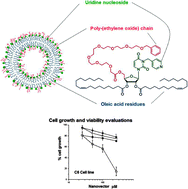Nucleolipid nanovectors as molecular carriers for potential applications in drug delivery
Abstract
Novel thymidine- or

* Corresponding authors
a
Dipartimento di Chimica Organica e Biochimica, Università degli Studi di Napoli “Federico II”, Complesso Universitario di Monte S. Angelo, via Cinthia, 80126 Naples, Italy
E-mail:
daniela.montesarchio@unina.it
b
Dipartimento di Chimica, Università degli Studi di Napoli “Federico II”, Complesso Universitario di Monte S. Angelo, via Cinthia, 80126 Naples, Italy
E-mail:
luigi.paduano@unina.it
c CSGI – Consorzio interuniversitario per lo sviluppo dei Sistemi a Grande Interfase, Italy
d Dipartimento di Farmacologia Sperimentale, Università degli Studi di Napoli “Federico II”, via D. Montesano 49, 80131 Naples, Italy
Novel thymidine- or

 Please wait while we load your content...
Something went wrong. Try again?
Please wait while we load your content...
Something went wrong. Try again?
L. Simeone, G. Mangiapia, C. Irace, A. Di Pascale, A. Colonna, O. Ortona, L. De Napoli, D. Montesarchio and L. Paduano, Mol. BioSyst., 2011, 7, 3075 DOI: 10.1039/C1MB05143A
To request permission to reproduce material from this article, please go to the Copyright Clearance Center request page.
If you are an author contributing to an RSC publication, you do not need to request permission provided correct acknowledgement is given.
If you are the author of this article, you do not need to request permission to reproduce figures and diagrams provided correct acknowledgement is given. If you want to reproduce the whole article in a third-party publication (excluding your thesis/dissertation for which permission is not required) please go to the Copyright Clearance Center request page.
Read more about how to correctly acknowledge RSC content.
 Fetching data from CrossRef.
Fetching data from CrossRef.
This may take some time to load.
Loading related content
